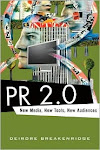 In any profession, one needs a qualification to add to the experience gained in order to prosper in a career. Personally, I decided to purse an MA in PR because I know it adds value to my way up in my career and gives me a better understanding of PR. There has been a debate on whether it was absolutely necessary to have specific PR qualifications in order to break in to the industry.
In any profession, one needs a qualification to add to the experience gained in order to prosper in a career. Personally, I decided to purse an MA in PR because I know it adds value to my way up in my career and gives me a better understanding of PR. There has been a debate on whether it was absolutely necessary to have specific PR qualifications in order to break in to the industry.Our last class was marked with a debate on the relevance of PR qualifications, whether success in Public relations is driven by contact and personal qualities or not. Some of my colleagues argued that experience and contacts counted more than the qualification. To some extent, I would agree with them, but then again at the end of the day one needs to understand the theoretical part of the subject of work he or she is doing. Stuart Bruce founder and managing director of Wolfstar, a specialist in PR, says that studying and accreditation are essential for: "first, basic principles and fundamentals. That is the history and ethics of public relations and how it works as a management function."
Also, to have a PR qualification may be significant to help professionalise the industry, as there have been debates that the PR industry is not professional. The qualification may help to boost the reputation of the PR profession which many tend to be perceived as negative, or in other words spin.
However, many job adverts would emphasize on personal qualities and capabilities of doing the job, with less emphasis on a PR qualification. It could be for this reason many people have worked in professions they are not qualified for, but simply because their credentials and personality match the job descriptions, they are selected to do the work.
In some countries like Kenya and many others, one may only need to have a Journalism or communication qualification to work in the PR industry. This is because only one university in the country offers PR as a full course, where as others offer it as a module/subject. Yet those, PR professionals have been able to carry out their duties with such qualification professionally and successfully.
But, I think if having a PR qualification as mandatory for what one requires to work in the industry, will help create boundaries and people from confusing PR for jobs such as marketing or advertising. Currently, PR is going through massive transition and there is no doubt that in future it will be difficult to break into the industry without a PR qualification.
Finally, I must say that I have learnt a great deal from the course and this was an interesting class. I wish all my colleagues success in their job search.

























